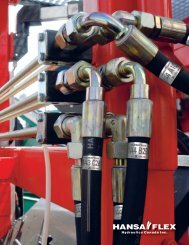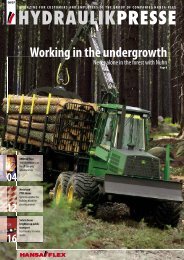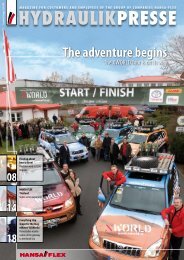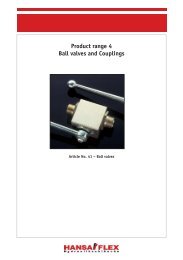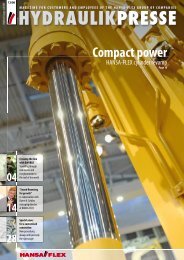HYDRAULIKPRESSE - HANSA-FLEX Hydraulics Canada Inc.
HYDRAULIKPRESSE - HANSA-FLEX Hydraulics Canada Inc.
HYDRAULIKPRESSE - HANSA-FLEX Hydraulics Canada Inc.
You also want an ePaper? Increase the reach of your titles
YUMPU automatically turns print PDFs into web optimized ePapers that Google loves.
TEREX GMBH<br />
In the search for crude oil rising oil prices and a foreseeable<br />
scarcity of resources have now prompted the<br />
exploitation of sources which were not previously lucrative<br />
enough. One example of this is the enormous<br />
oil sand fi elds at Fort McMurray in <strong>Canada</strong>.<br />
The province of Alberta contains around one third<br />
of the world’s available stocks of oil sand, which is<br />
mined at open pits by mighty crawler excavators. It<br />
is here that North America’s largest crude oil producer<br />
Syncrude <strong>Canada</strong> Ltd. (SCL) operates three<br />
opencast mines. Gigantic RH 400 mining excavators<br />
from Terex O&K are used to extract the oil sand.<br />
Terex GmbH based at Dortmund, a successor company<br />
to O&K AG founded in 1876, has repeatedly set<br />
milestones in the development of hydraulic excavators<br />
and specialises in extraction and conveying<br />
at opencast mines. At Fort McMurray not only hydraulic<br />
but also cable-operated and bucket-wheel<br />
6<br />
Mining excavators - giants in oil sand<br />
„Works in works“ - a tried and tested concept<br />
<strong>HYDRAULIKPRESSE</strong><br />
excavators are in use. Among them is the RH 400.<br />
With an operating weight of some 1,000 tons it is<br />
the world’s largest hydraulic excavator, with jumbosized<br />
dimensions. The excavator bucket alone has a<br />
capacity of 45 cubic metres, able to handle around<br />
100 tons of oil sand in a single pass. This calls for<br />
enormous forces - something that the RH 400 can<br />
deliver thanks to an engine output of 4400 HP and<br />
hydraulics that can cope with operating pressures<br />
of up to 310 bar. Oil sand can be mined in winter<br />
at - 40 °C when the ground is frozen rock-hard, but<br />
also in summer at + 40 °C when the oil sand has<br />
become a stringy mass.<br />
The extracted oil sand is then loaded onto gigantic<br />
heavy-duty trucks with payloads of up to 360 tons,<br />
which take it away for processing, fi nally resulting<br />
in the coveted crude oil. Four buckets from a RH<br />
400 will fi ll a heavy-duty truck. The mining excava-<br />
tor is controlled from the third fl oor so to speak. It<br />
is at this level that the driver’s cab is to be found,<br />
equipped with a control panel as well as a kitchenette<br />
complete with microwave and area for relaxing.<br />
The precise control system is designed to ensure<br />
easy operation although the skill of the driver<br />
also plays a key role here. Surprisingly, women are<br />
now increasingly to be found in this job: Experience<br />
has shown that they handle their machines with<br />
greater fi nesse.<br />
Ordered at short notice, delivered<br />
promptly<br />
A new RH 400 from Terex O&K is already scheduled<br />
to go into service at one of the three oil sand deposits<br />
in Alberta in January 2008. The time scale<br />
from ordering the mining excavator from the German<br />
manufacturer to commissioning is rather<br />
tight. Nowadays the construction of such mighty<br />
“workhorses” must be performed in record time.<br />
Once a mining company has decided to exploit<br />
a new oil fi eld, it cannot wait months for delivery<br />
of the machine required. For Terex O&K as the<br />
partner to the mine operator this makes high demands<br />
on its readiness to deliver. There must be<br />
no delay in assembly under any circumstances.<br />
Terex O&K therefore expects each subsupplier to<br />
off er special services, something that naturally<br />
also applies to the manufacturers of the hydraulic<br />
connecting elements. The completed excavator is<br />
based on designs, drawings and parts lists from an<br />
existing model but this was last built by Terex O&K<br />
three years ago - mining excavators of these dimensions<br />
are not mass-produced on an assembly line.<br />
As technical progress has not stood still since then,<br />
technological advances must of course also be taken<br />
into account and incorporated during construction<br />
of the machine. This may involve new units with<br />
modifi ed connections or new routings for pipes and<br />
hose lines, which have come about from the experiences<br />
evaluated by the operator over the last few<br />
years. In such cases fi ttings need to be changed,<br />
as well as nominal widths, with pipe manifolds<br />
ISSUE DECEMBER 2007



